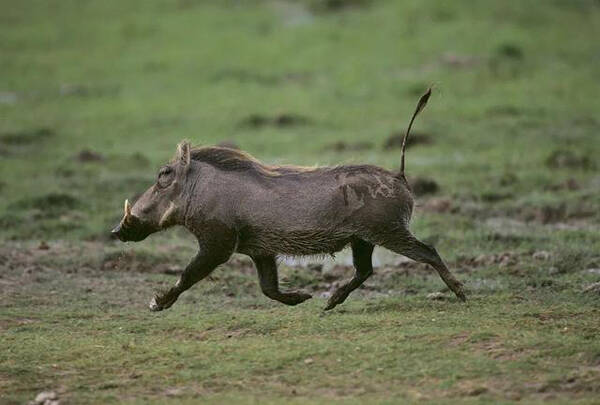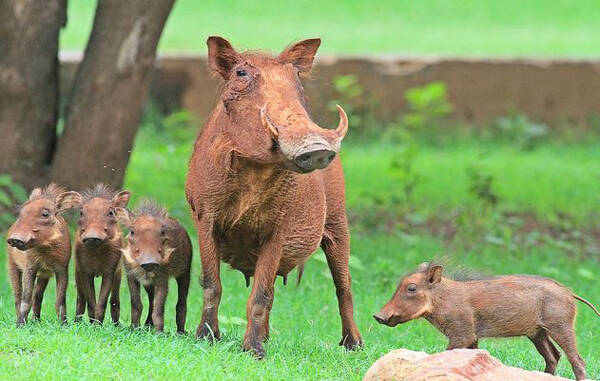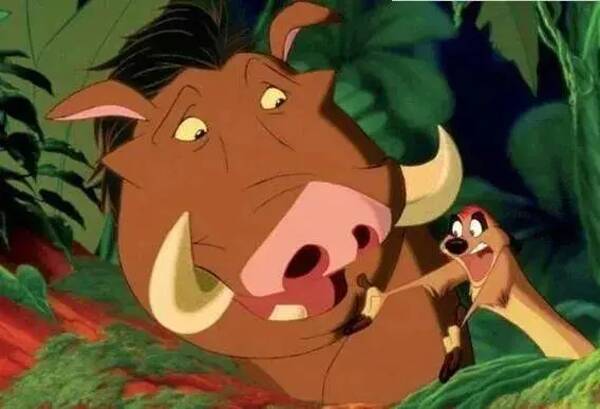Phacochoerus africanus
IUCN
LCBasic Information
Scientific classification
- name:Phacochoerus africanus
- Scientific Name:Phacochoerus africanus,Common Warthog,Common warthog, Eritrean warthog
- Outline:Ungulata
- Family:Artiodactyla Suidae Pterochoerus
Vital signs
- length:91-150cm
- Weight:50-150kg
- lifetime:About 15 years
Feature
Named after the warts under the eyes
Distribution and Habitat
Origin: Angola, Benin, Botswana, Burkina Faso, Burundi, Cameroon, Central African Republic, Chad, Congo, Democratic Republic of Congo, Côte d'Ivoire, Djibouti, Eritrea, Ethiopia, Gabon, Gambia, Ghana, Guinea, Guinea-Bissau, Kenya, Liberia, Malawi, Mali, Mauritania, Mozambique, Namibia, Nigeria, Rwanda, Senegal, Sierra Leone, South Africa, Sudan, Swaziland, United Republic of Tanzania, Togo, Uganda, Zambia and Zimbabwe.
Possibly extinct: Congo.
Prefers warm climates, limited to wet and dry African savannas, open jungles and woodlands, generally active in areas with year-round surface water. Usually forests, scrub, cool mountain grasslands and desert areas. Occupies forest areas and rural fields in parts of eastern Africa. Vertical height can reach 3,500 meters.
Appearance
African warthogs are 0.91-1.5 meters long, 0.64-0.85 meters tall, and weigh 50-150 kilograms. Females weigh 15% to 20% less than males. They are named after the pair of large warts that grow below their eyes. Male warthogs have another pair of smaller warts on their snouts, above their tusks. These warts may help protect their eyes while digging for food. African warthogs are thinner than ordinary pigs, with flat backs and fairly long limbs. The eyes of this animal are located on the upper part of the face, which allows them to detect predators from a long distance.
The head of an adult warthog appears to be very large, accounting for one-third of the body length. The head is seriously disproportionate to the body and looks heavier than the body. The body is cylindrical, with dark brown to black bristles on the back, and the long black bristles extend from the nape of the neck to the middle of the back, and a little short of the hips. Both males and females have four tusks, which ar
Details
African warthog (scientific name: Phacochoerus africanus) is called Common Warthog in foreign language, and there are 4 subspecies.

African warthog is a highly social animal. They often form small family groups, usually consisting of one or more female warthogs and their young. Single adult male warthogs sometimes join the group. African warthogs like to lie together and groom each other with their mouths and teeth.
African warthogs are preyed upon by many African carnivores, including spotted hyenas, wild dogs, cheetahs, lions, leopards and eagles. When danger comes, they will retreat to their caves if possible. In a fight, African warthogs can defend themselves with their long lower canine teeth, giving them a little more advantage. Apart from predators, warthogs don't care about other animals on the African savannah, and they will go about their business peacefully. Yellow hornbills are birds that live together with African warthogs, and they are allowed to eat the parasites on the warthogs.
They live alone or in groups, and are good at digging holes, which can avoid predators and prevent exposure to the sun. Although they are very good at digging holes, they still use the holes that other animals have dug as their own homes. When they enter these holes, they enter with their hindquarters first, and always face the hole entrance, so that they can use their fangs to fight intruders first. When they wake up every morning, they will rush out of the cave at high speed to avoid any predators that may be waiting at the hole entrance. Aggressive. Feed on grass, moss and tuberous plants, and occasionally eat carrion. Like mud baths. They have strong survival ability and are very adaptable to high temperature and drought environments. They can go without water for several months.

African warthogs can run at speeds of up to 54.4 kilometers per hour, and they usually trot with their tails erect. When eating, African warthogs kneel on the ground to eat grass and dig the ground with their noses. When raised by humans, an uneasy African warthog will run around its fence, making long screams and strong snoring sounds.
In the rainy season, African warthogs survive by eating the long grass on the savannah; in the dry season, they use their tusks and mouths to dig underground bulbs and tubers to eat. Because of the digging skills trained by finding food, African warthogs have extraordinary abilities in finding delicious things underground, so African warthogs are beneficial to the land they live in. When they eat the roots of plants, the stirring of the soil makes the soil loose and breathable, which can help the growth of plants in the future. They also eat ripe fruits that fall from trees, and occasionally eat carrion. When raised by humans, they eat carrots, sweet potatoes, lettuce, cabbage, bananas, apples and a mixture of grains.
Warthogs living in hot and rainy areas can mate at any time of the year, while populations in arid desert environments generally budget to give birth to piglets when the rainy season arrives. Warthogs will not find new mates in the same breeding season. The battle between two males for mates is very fierce. There is only one way to duel: ramming each other. In a sense, the big head of the warthog is born for this. The bloody battle often leaves a fatal wound to the loser.
The warthog family consists of an adult female and 5-10 piglets, mainly 5. Breeding is seasonal: mating mainly occurs during May or June, and the peak period of piglet birth occurs in November and December. The number of piglets varies from two to six, mainly three or four. The age of first birth is 2 years, the interval between births is 12 months, and the female has a lifespan of 12 years. The gestation period of a sow is 170-175 days, and each litter gives birth to no more than four piglets. Before giving birth, the sow will drive away the children of the previous litter and live in seclusion alone until the new generation of children is born. After choosing a mate, warthogs will not look for another partner in the same breeding season. In rainy areas, they can breed all year round, and in drier areas, breeding is seasonal. Piglets are born when the rainy season comes, and heavy rains bring abundant food. They have strong fertility. Due to the special shape of their reproductive organs, the end of the male pig's penis is spiral, which fits the spiral canal of the female pig's cervix, so sperm can directly enter the uterus. They have strong fertility.

"Pumbaa" in the cartoon "The Lion King", one of Simba's best friends, the real identity of "Pumbaa" is the African warthog.
The total number of warthogs in South Africa is estimated to be at least 22,250 (Swanepoel et al. 2016). The number in other southern African countries is still inconclusive. In East Africa, it does not exist or the density is very low. Populations are suspected to be declining in most populations across much of the geographic range (2014). Typical densities range from 1-10 animals/km2 of protected areas (Cummings, 2013), but local densities of 77/km2 have been recorded in the short grass areas of Nakuru National Park in central Kenya. Natural climatic and extreme events are the main causes of mortality in African warthogs, including drought, rinderpest, predation and desertification, as well as habitat degradation, loss and fragmentation from human reclamation, road construction and other developments, competition with domestic livestock for water and food, hunting for sport, bushmeat, trade in skins and tusks (only upper tusks are considered trophies), use as bait in response to crop raiding by large carnivores, grazing pressure and eradication programs (2014).
Listed on the IUCN Red List of Threatened Species (IUCN) 2016 ver 3.1 - Least Concern (LC).
Protect wild animals and stop eating game.
Maintaining ecological balance is everyone's responsibility!








